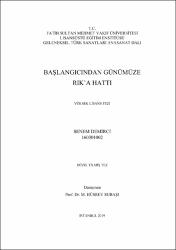Başlangıcından Günümüze Rık'a Hattı
Künye
DEMİRCİ, Senem, Başlangıcından Günümüze Rık'a Hattı, Fatih Sultan Mehmet Vakıf Üniversitesi Lisansüstü Eğitim Enstitüsü Geleneksel Türk Sanatları Anabilim Dalı, Yayımlanmamış Yüksek Lisans Tezi, İstanbul 2019.Özet
İslâm yazıları arasında yer alan Rık’a, aklâm-ı sitte’den hayli sonra Osmanlıların icâdı
ile ortaya çıkmış bir yazıdır. Seri ve kolay yazılmaya müsait bir yazı olması bakımından
XVIII. asırdan itibaren resmî yazışmalarda, mektup, müsvedde ve matbu‘atta çokça
tercih edilmiştir. Ayrıca XIX. yüzyıldan itibaren taşa mahkûk eserlerde de kendini
gösteren rık’a, celî olarak da kullanılmaya başlanmıştır.
Diğer hat nevilerine nazaran sanat yazısı olarak addedilmeyen rık’anın, bilhassa celîsi
hatrı sayılır bir ifade gücüne sahiptir. Günümüzde, yeni denemeler ve çalışmalar
yapılarak levha sanatında da kullanılır hale gelen bu yazı yeniden ihya edilme
yolundadır.
Başlangıcından günümüze rık’a hattının serüvenini konu aldığımız bu çalışma ile evvela
rık’anın daha iyi anlaşılabilmesi ve tanıtılması amaçlanmıştır. Resmî ve husûsî
arşivlerden derlenen örnekler ve rık’anın kullanım alanları incelenerek bu yazının nasıl
bir gelişim gösterdiği kronolojik olarak ele alınmıştır. Ruqʿah, which is among Islamic scripts, is a script that emerged with the invention of
the Ottomans well after the six traditional arabic scripts (al-aqlām al-sittah). It is widely
preffered in official correspondance, letters, drafts and printed publications since XVIII.
century because of being appropriate to be written easily and rapidly. Additionally,
ruq’ah, which has been seen on artifacts that sculpted on stones since XIX. century, is
also started to be used as jali.
Ruqʿah, which is not regarded as an art script beside (compared to) other Islamic
scripts, has a considerable power of expression, especially its jali ones. Nowadays, this
script which is started to be used in plate art by making new trials and works, is again
on the way to revive.
The primary aim of this work, in which we handled the adventure of the ruq’ah script
from the beginning to the present, is to introduce ruq’ah and to provide a better
understanding of it. The development of this script discussed in chronological order by
examining the usage areas of ruqʿah and the text samples collected from the official and
private archives.



















